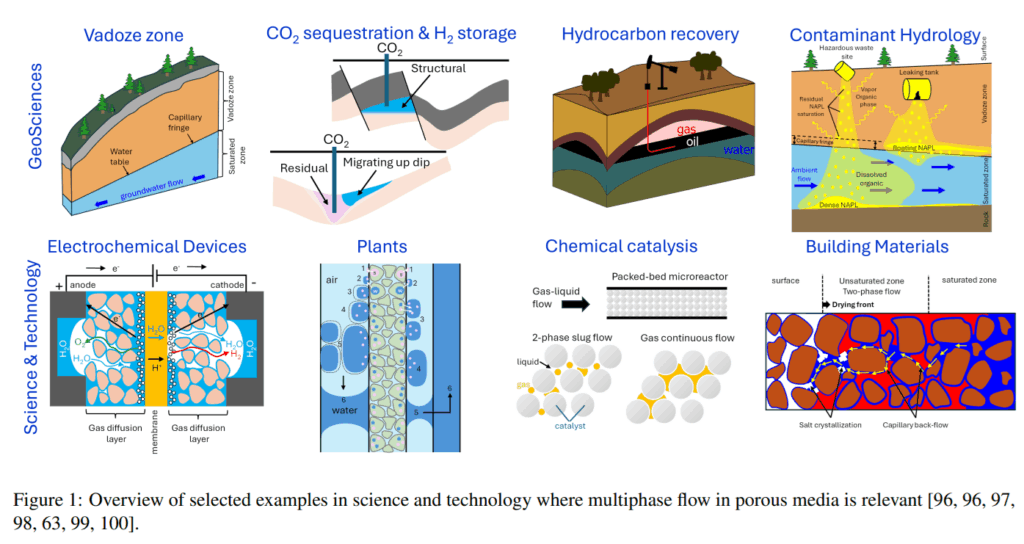
“From Interface Dynamics to Darcy Scale Description of Multiphase Flow in Porous Media“, an invited submission to a special issue in Advances in Colloid and Interface Science, authored by Steffen Berg, Ryan Armstrong, Maja Rücker, Alex Hansen, Signe Kjelstrup and Dick Bedeaux was just released as preprint on
https://lnkd.in/eGBVwfwV
In this review, we compare novel concepts which have been largely motivated by experimental insights, enabled by significant advances in pore-scale imaging and modeling over the last decade. The novel approaches are deeply rooted in non-equilibrium and statistical thermodynamics and cover the three dominant flow regimes. They naturally include the spatio-temporal dynamics of fluctuations which have been observed experimentally from pore to Darcy scale. This review outlines some recent achievements but also emphasizes the many open questions and invites the community for future work on the topic.
Abstract:
An outstanding characteristic of porous media, desired in many applications, is the large surface area, which facilitates solid-fluid interactions, making porous media an extreme case in colloid and interface science. In two-fluid systems, wetting and the balance of capillary and viscous forces control fluid displacement processes, leading to a wide range of complex flow regimes with rich spatio-temporal dynamics. Macroscopic two-phase flow is historically described through the phenomenological extensions of Darcy’s law. Besides many other shortcomings and inconsistencies, it covers only connected pathway flow in the capillary-dominated flow regime in a rigorous manner while other flow regimes with moving interfaces and associated topological changes are entirely implicit.
Given the lack of adequate descriptions, upscaling multiphase flow from pore to Darcy scale represents a long-standing challenge paving into the fields of thermodynamics, statistical mechanics and integral geometry. In this review, we compare novel concepts which have been largely motivated by experimental insights, enabled by significant advances in pore-scale imaging and modeling over the last decade.
They cover the three dominant flow regimes in a rigorous manner: (I) the capillary-dominated regime, consisting mainly of connected pathway flow with capillary fluctuations covered by the space-time averaging approach and by the extended nonequilibrium thermodynamic theory (NET), resulting in linear laws; (II) the nonlinear flow regime, where capillary states become increasingly accessible by viscous mobilization leading to ganglion dynamics and intermittency, which is described by the statistical thermodynamics approach; and (III) the viscous limit consisting mainly of drop-traffic, which leads again to a linear law described by the NET approach, which utilizes the fluctuation-dissipation theorem and Onsager reciprocal relationships. Most applications are in regime I which is the most complex and least intuitive to understand because it is a ”frozen state”. It is more intuitive to start with regime III being from the perspective of dynamics the most comprehensive, and then approach successively regime II and I.
Spatio-temporal fluctuations are an inherent part of the novel approaches and thereby avoid previous limiting assumptions, which in key aspects are inconsistent with experimental observations of fluctuations from pore to Darcy scales. Currently only a minimum set of state variables is used to provide a proof of concept which can be extended to the four Minkowski functionals, representing the geometric state variables for capillarity.
We conclude with open questions and invite to contribute to steer the theoretical advances towards application. The most immediate being the use of the fourth new concept, the co-moving velocity, which utilizes inherent symmetries in the 2-phase Darcy equations, to constrain the functional form of relative permeability-saturation relationships for either validating the relative permeability data or simplifying the relative permeability measurements.
In the future, the choice of state variables and the statistical thermodynamics approach that establishes relationships between them can be used to replace empirical hysteresis models. More generally, the more rigorous grounding of transport laws in thermodynamic concepts opens new possibilities for the study of coupled transport phenomena, including phase behavior/phase changes and other more complex processes, e.g., in electrochemical devices.

